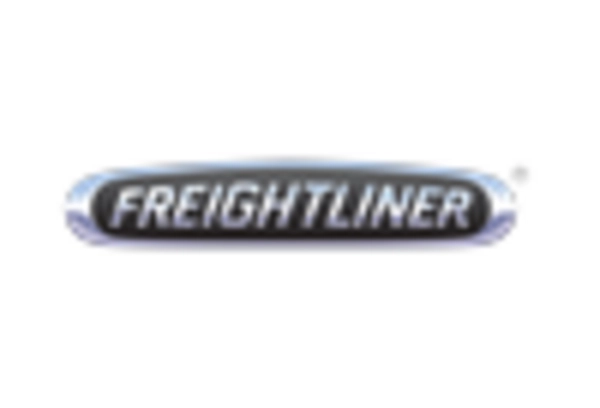Increasing Demand for E-commerce
The rise of e-commerce has led to a substantial increase in demand for logistics and transportation services. As businesses expand their online presence, the need for Class 7 trucks to facilitate last-mile delivery becomes more pronounced. In 2025, the Class 7 Truck Market is projected to experience growth driven by this trend, as companies seek efficient solutions to meet consumer expectations for rapid delivery. The demand for Class 7 trucks is likely to be influenced by the expansion of distribution centers and warehouses, which require reliable transportation to move goods swiftly. This shift in consumer behavior appears to be a key driver, as it necessitates a robust fleet of trucks capable of handling increased volumes of shipments.
Infrastructure Development Initiatives
Infrastructure development initiatives undertaken by various governments are likely to bolster the Class 7 Truck Market. Investments in road networks, bridges, and transportation hubs are essential for enhancing logistics efficiency. In 2025, the anticipated increase in infrastructure spending could lead to improved routes for Class 7 trucks, facilitating smoother operations for logistics companies. Enhanced infrastructure not only reduces transit times but also minimizes vehicle wear and tear, thereby lowering operational costs. This trend suggests that as infrastructure improves, the demand for Class 7 trucks will likely rise, as businesses seek to capitalize on the benefits of more efficient transportation systems.
Shift Towards Alternative Fuel Sources
The Class 7 Truck Market is witnessing a notable shift towards alternative fuel sources, driven by the need for sustainability and cost-effectiveness. As fuel prices fluctuate, businesses are increasingly exploring options such as compressed natural gas (CNG) and electric vehicles. In 2025, the market is expected to see a rise in the adoption of Class 7 trucks powered by alternative fuels, as companies aim to reduce their carbon footprint and operational costs. This transition may be further supported by government incentives and subsidies for cleaner technologies. The growing emphasis on sustainability appears to be a significant driver, as businesses recognize the long-term benefits of investing in alternative fuel solutions.
Regulatory Compliance and Emission Standards
The Class 7 Truck Market is significantly influenced by regulatory compliance and stringent emission standards. Governments worldwide are implementing regulations aimed at reducing carbon emissions and promoting cleaner technologies. In 2025, the market is expected to see a shift towards trucks that meet these evolving standards, as companies strive to avoid penalties and enhance their sustainability profiles. This regulatory landscape may drive innovation in the Class 7 truck segment, as manufacturers develop vehicles equipped with advanced emission control technologies. Consequently, the demand for compliant trucks is likely to increase, as businesses prioritize adherence to regulations while maintaining operational efficiency.
Technological Integration in Fleet Management
The integration of advanced technologies in fleet management is poised to transform the Class 7 Truck Market. Innovations such as telematics, GPS tracking, and route optimization software are becoming increasingly prevalent. These technologies enable fleet operators to monitor vehicle performance, reduce fuel consumption, and enhance overall efficiency. In 2025, the adoption of such technologies is expected to drive demand for Class 7 trucks equipped with these features. As companies seek to optimize their logistics operations, the ability to leverage data analytics for decision-making will likely become a critical factor in selecting vehicles. This trend suggests that technological advancements will play a pivotal role in shaping the future of the Class 7 truck market.


















Leave a Comment